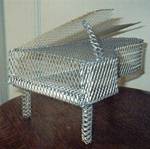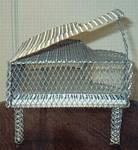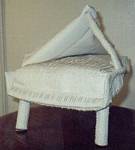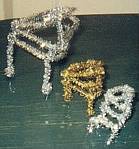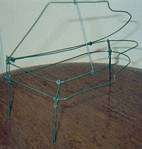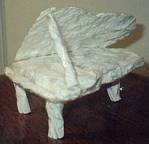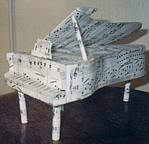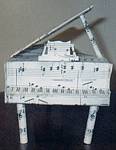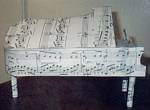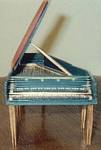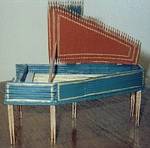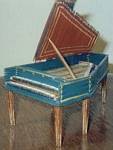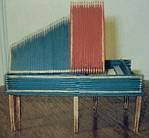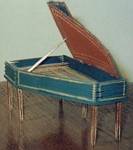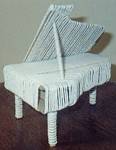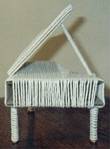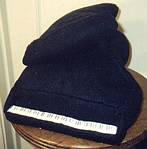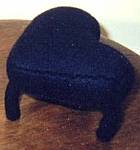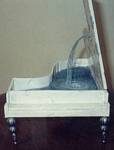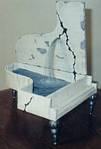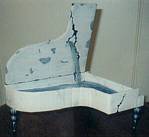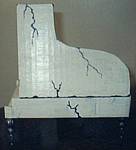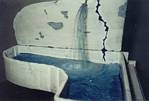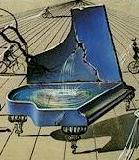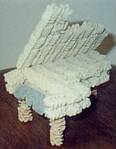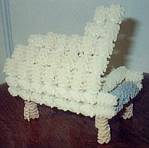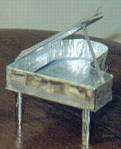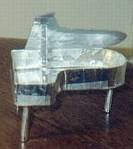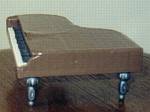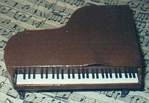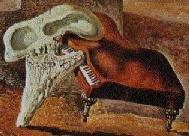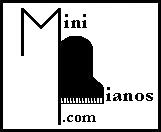
Page 1: Museum Highlights
Though the majority of miniature pianos in my collection were purchased, I have made several over the past few years. I have made pianos from fabric, cardboard, foil, paper, toothpicks, and even pasta! Here is what I have made. These are listed in the approximate order in which I made them. |
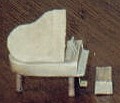

This is a tiny piano I made for a theatrical design class in college. As far as I recall, it is the first mini piano I ever made. It was part of a scale model of my living room and, as such, is meant to represent my real piano. I made the body out of thick paper and the legs are actually from a lollipop stick. The piano is colored and detailed with watercolor pencils and the sheet music is detailed in pen. It measures 1 1/4" across by 1 1/2" high. Materials used: paper, lollipop stick, watercolor pencils, pen, glue, scotch tape. |
I made this piano out of gutter wire, cut and then sewn together using wire thread. The keyboard was a stroke of luck: I had taken a picture of my piano, and the size of the keyboard in that picture exactly matched the width of the gutter wire piano! So I used the photograph of my piano's keyboard as the keyboard for the wire piano. This piano measures 6" across by 7" high. Materials used: gutter wire, wire thread, photograph. |
I made the piano on the left out of fabric I had lying around. The idea was to make a "stuffed animal" piano. This one is really a prototype, and is stuffed with tissue paper. The keyboard is drawn on with pencil and I sewed in some gold thread as the piano's strings. The lid is attached to the prop stick with a snap. The piano measures 7 1/2" across by 9" high. Materials used: cream fabric, thread, snaps, tissue paper, pencil, wire (for leg reinforcement). The trio of pianos on the right was made from metallic pipe cleaners, bent and wrapped to form the piano shape. They range in size from 1" across and 2 3/4" high to 1 1/2" across and 3 1/4" high. Material used: pipe cleaners. |
I made the piano on the left out of floral wire, which I bent into the piano shape. This delicate piano has difficulty standing up! It measures 3 1/2" across by 5 1/2" high. Material used: floral wire. The piano on the right is made out of wadded up pieces of paper encased in a wrap of clear tape. Don't ask me where I come up with these ideas. I really don't know! This piano measures 4" across by 5" high. Materials used: paper, clear tape. |
This piano is made out of sheet music. Connoisseurs might recognize this piece as a Chopin nocturne (if you can name the exact piece, I'll give you a 10% discount in the gift shop!). I love playing this piece, so I copied the sheet music and made a piano out of it. The piano body itself is hollow - just paper - and the legs and prop stick are rolled up papers. The piano is held together with tape. Even the keyboard is made out of the Nocturne sheet music: I cut and taped together pieces from the music staff to be the white keys, and the black keys are painstakingly cut from the music bars! This piano measures 4" across by 6" high. Materials used: sheet music, scotch tape. |
Of all the miniatures I have made, I consider this to be one of the masterpieces. It is a harpsichord made out of toothpicks. The reason it became a harpsichord is that toothpics don't bend, so a more angular harpsichord was easier to craft than a curvy piano body. The body, lid, soundboard, keyboard, and legs are all made out of toothpicks; the only other things used are cardboard underneath the soundboard for sturdiness and then gold thread as the strings. The black keys are etched into the toothpicks with a knife and the white keys are individually painted on. One of the most difficult things in making this model is that I really had nothing to base it on. I had a harpsichord CD and I consulted the picture on the cover, but most of this model's detail was from my imagination. Of course, these days I know a lot more about harpsichords and even have one in my home, so if I ever make another model, surely it will be more "anatomically correct." This harpsichord measures 3" across by 4 3/4" high. Materials used: toothpicks, cardboard, strings, paint, glue, scotch tape. |
This "mummy" piano is actually a frame crafted out of cardboard and then wrapped in string. I think I got the idea from a publicity photo of Tori Amos that featured her playing a mummy-wrapped piano. This piano measures 4" across by 6" high. Materials used: cardboard, string, glue. |
Here are two pianos I made out of plush black fabric. They are filled with regular stuffing. The larger one has a white ribbon as a keyboard, with the keys marked on with a black pen. I made a second one like this with keyboard-patterned ribbon as a present for Tori Amos. The large plush measures 9" across by 8" high. The small plush measures 4" across by 3" high. Materials used: fabric, stuffing, ribbon, pen, thread. |
Of all the models I have made, I am proudest of the toothpick harpsichord and of this "Piano Fountain after Dali." It is inspired by a Salvador Dali painting entitled Musical Tempest (1957), which depicts a decrepit white piano with a fountain flowing in it. My Dali piano fountain is primarily based on that painting, with some inspiration taken from his painting Sentimental Colloquy (1944), which also has a piano fountain in it. Dali actually used piano images in many of his paintings; pianos are a recurring motif in his work. Anyway, I went all out with this one, using as much detail as I could. The piano is made of cardboard. The surface was distressed using paint and charcoal. I painted the large cracks to look three-dimensional. I surmised what the top of the piano lid might look like and painted water leaking out of the cracks. The piano's legs I crafted from wooden beads strung on toothpicks and then painted with a faux relief to match the Dali pianos. The water spray itself is made of thread, treated with hairspray for stiffness. The water basin was the trickiest part. A translucent acrylic material would have been best, but I didn't know how on earth to get such a thing. So the effect was achieved using layer upon layer upon layer of blue saran wrap! That was the best I could think of. The ripples in the water I simulated using paint. Though not flawless, I was very pleased with how this one turned out. It measures 5 1/2" across by 8" high. Materials used: cardboard, masking tape, paint, charcoal, saran wrap, thread, beads, toothpicks, glue, hairspray. Pictured below this piano are the Dali pianos on which mine was based. Click those pictures to view each entire painting. |
This piano pays homage to the TV show Seinfeld. It was inspired by the episode where Kramer makes a little statue of Jerry out of pasta. He calls it "Fusilli Jerry" as it is made out of fusilli (chosen because Jerry is "silly"). Now I didn't know what pasta would be appropriate for a piano, but I used some I had on hand: tri-colored radiatore pasta. This piano measures 3 1/4" across by 4 3/4" high. Materials used: pasta, glue. |
This piano is simply made of aluminum foil, scotch tape, and glue. It measures 2 1/2" across by 3 1/4" high. |
This one is my other homage to Dali and is based on a piano in Dali's painting Atmospheric Skull Sodomizing a Grand Piano (1934). I call this "Transverse Piano after Dali" because of the keyboard's unusual position. This one is made out of cardboard and the legs are made of beads like the piano fountain. The black keys are tiny chopped-up bits of painted toothpicks. You will notice that I made this piano exactly in as in the painting, with the suggestive opening the naughty skull is probing! It measures 5" across (keyboard side) by 2" high. Materials used: cardboard, paint, masking tape, beads, toothpicks, glue. Pictured below this piano is the Dali piano on which mine was based. Click that picture to view the entire painting. |
Copyright 2001 MiniPianos.com
